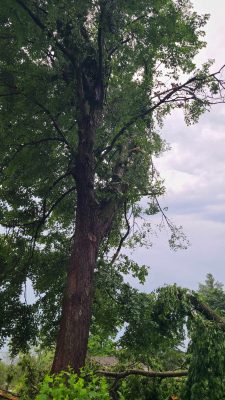By Nick Goltz, DPM, UConn Plant Diagnostic Lab/UConn Home & Garden Education Center
The forecast is looking good for a perfect 4th of July weekend. Most folks will take advantage of the weather ahead to plan that perfect grilling menu for when their friends and family visit. This is a much-needed respite from the severe weather that passed through over the past few weeks. Severe winds and torrential rains hammered Connecticut and most of the rest of the Northeast after a recent heat wave. With the weather for the week ahead of us is looking much better than the weather of the week behind us, now is the perfect time to assess our trees and determine if any action needs to be taken before the next storm comes!

I’ll start and end this column with the advice that a professional arborist should be called-in if you are ever unsure of your tree’s health, or if you need support regarding safe management and potential removal. In Connecticut, one of the best resources for finding a licensed, local arborist as well as additional resources regarding tree care and maintenance can be found on the Connecticut Tree Protective Association website, ctpa.org. That said, tree triage can start with you at home. There are many things one can be on the lookout for to determine if a tree need professional attention, and potentially in what order the work should be done.
I’m sure you’ve heard this phrase used to describe real estate, but with trees too, location is everything. The first thing to consider when performing your tree triage is the location of the tree. Regardless of tree age, size, species, or health, the trees that should always merit our immediate attention are those in locations where they could pose a danger to life or property if a limb were to fall off or if the tree were to topple altogether. Trees within striking distance of homes, power lines, and important structures like chicken coops and pet houses should always be the first inspected before the storm comes and after it passes. If a tree knocks down a power line or hits a home, call for help. Never attempt to work around a live cable (one that still carries electricity) without the proper training and equipment.
The second thing to consider as you perform your tree triage is health of the tree. Trees weakened by disease or age are more likely to succumb to strong winds or topple after standing water weakens or kills roots. Inspect your trees for symptoms of stress and disease such as branches that no longer produce leaves. Depending on the species of tree, a few may not be much cause for concern, but if there are several branches on a tree that no longer produce new leaves or needles, the tree is likely not in great health. Another symptom of stress or disease is a visible canker, or large wound, on the trunk of the tree. Trees in good health will typically grow new tissue over an injury sustained by pruning, animal feeding, or a previous storm. Cankers that appear to be getting larger over a few years, rather than smaller, are often a cause for concern.
There are even some obvious signs of disease such as conk or shelf mushrooms that grow directly from the wood of the tree. While these organisms are important for nutrient cycling in natural ecosystems, they often indicate that a tree is approaching the end of its life. The shelf mushroom is only the sexual structure of the fungus, there to produce spores and reach new trees. While removing the mushroom may slow the spread of the fungus to other trees nearby, the majority of the “body” of the fungus will still exist within the tree, weakening it by breaking down woody tissue over time.
Trees, like other living things, do not live indefinitely and become more vulnerable to illness and stress as they age. Just like people need to take care of themselves to ensure they live a long, healthy life, so too must trees be cared for over the course of their lives to ensure they have the best possible outcome. Regular fertilization and pruning are essential to not only ensure that a tree grows robustly, but also that it does not become lopsided or heavy on one side as it ages. Even healthy trees can fall if they are never pruned and have a poor center of gravity! Pruning should be performed frequently to promote new growth, discourage lopsidedness, and allow increased airflow through the canopy. This will have the double benefit of decreasing disease pressure that often accompanies high canopy humidity and prolonged leaf wetness. Though it depends on the species of tree, most here in New England perform best when pruned while they are dormant in winter. Remember to not remove more than 1/3 of the tree’s branches when pruning, if possible!
There are other factors to consider when determining if a tree should come down that we don’t have space to discuss at length here, such as the species of tree, whether the tree is used for other purposes (such as part of a living fence), whether the tree has historic or personal significance, or what removal of the tree may mean for other plants nearby that depend on its shade. And, of course, nobody should consider tree removal without considering cost and time. If cost is a concern, remember to do your triage and prioritize the management of trees that could potentially damage your home, property, or power lines if they were to fall. These considerations and others are worth discussing with an arborist as they survey your property!
For questions about planting and pruning trees or other gardening topics, feel free to contact us, toll-free, at the UConn Home & Garden Education Center at (877) 486-6271, visit our website at www.homegarden.cahnr.uconn.edu or contact your local Cooperative Extension Center.